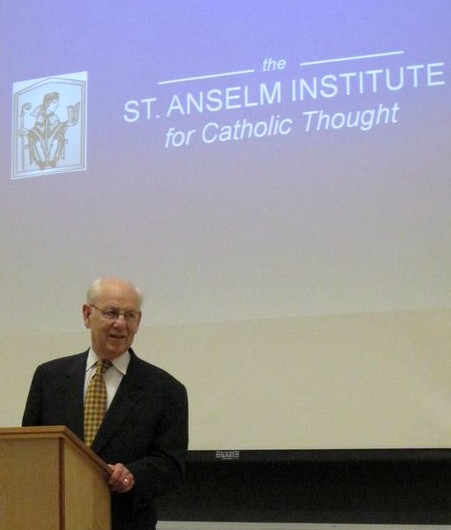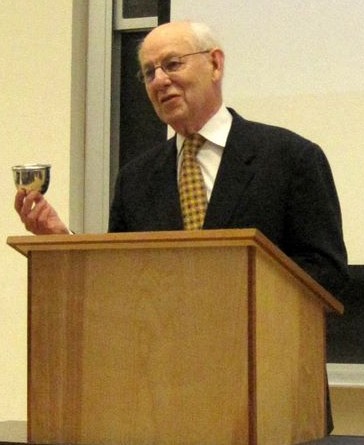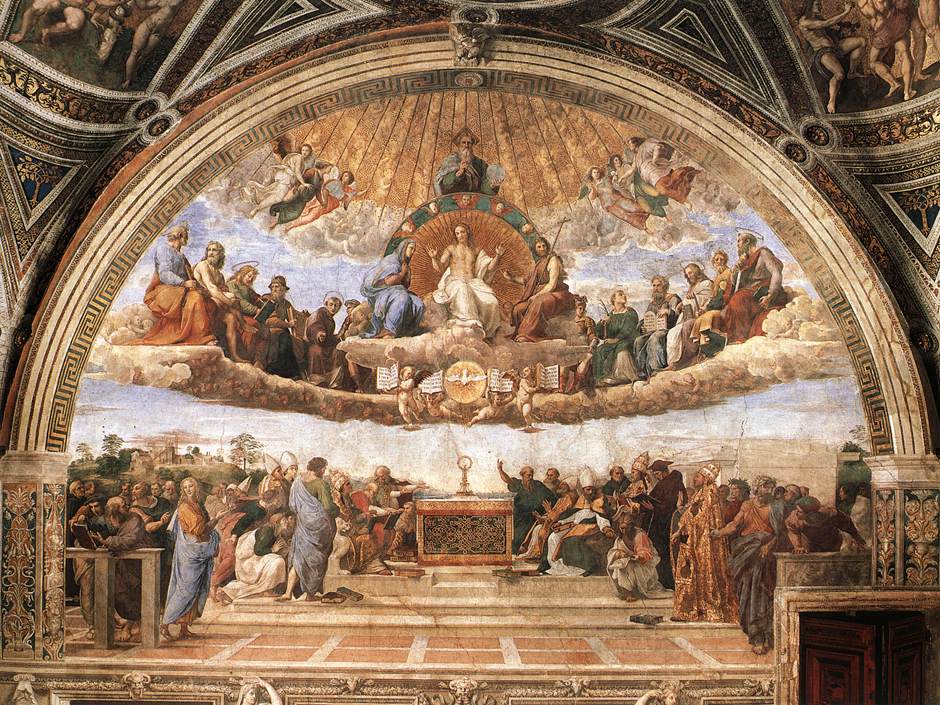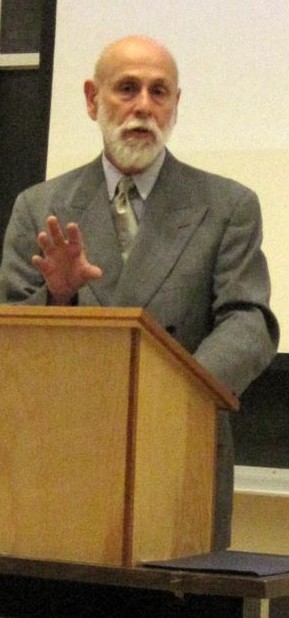Robert Louis Wilken
"Catholicism and Culture"
Thursday / March 25, 2010
UVA / Minor Hall Auditorium / 5:00-7:00pm
 On the Feast of the Annunciation, the faculty and friends of the St. Anselm Institute for Catholic Thought welcomed back Robert Louis Wilken by inaugurating the annual Robert Louis Wilken Lecture in honor of his dedicated service to and leadership of the St. Anselm Institute since its founding in 2000.
The University of Virginia Department of Religious Studies cosponsored this public lecture.
On the Feast of the Annunciation, the faculty and friends of the St. Anselm Institute for Catholic Thought welcomed back Robert Louis Wilken by inaugurating the annual Robert Louis Wilken Lecture in honor of his dedicated service to and leadership of the St. Anselm Institute since its founding in 2000.
The University of Virginia Department of Religious Studies cosponsored this public lecture.
Robert Louis Wilken, the William R. Kenan, Jr. Emeritus Professor of Religious Studies at the University of Virginia, is the author, editor and translator of numerous scholarly books and articles, including Isaiah: Interpreted by Early Christian and Medieval Commentators (Eerdmans, 2007); The Spirit of Early Christian Thought: Seeking the Face of God (Yale, 2003); On the Cosmic Mystery of Jesus Christ: selected writings of St. Maximus the Confessor (St. Vladimir's Seminary Press, 2003); Remembering the Christian Past (Eerdmans, 1995); The Land Called Holy: Palestine in Christian History and Thought (Yale, 1992); Christians as the Romans Saw Them (Yale, 1984); and The Myth of Christian Beginnings (Doubleday, 1971).
On the Cosmic Mystery of Jesus Christ: selected writings of St. Maximus the Confessor (St. Vladimir's Seminary Press, 2003); Remembering the Christian Past (Eerdmans, 1995); The Land Called Holy: Palestine in Christian History and Thought (Yale, 1992); Christians as the Romans Saw Them (Yale, 1984); and The Myth of Christian Beginnings (Doubleday, 1971).
Prof. Wilken used the copy of Raphael's School of Athens painting in UVA's Cabell Hall Auditorium as an initial point of reference. He noted the original painting not only depicted Plato and Aristotle and the greatest minds of ancient Greece, but that Raphael also painted a companion work known as the Adoration of the Sacrament. Both paintings hang on opposite walls in the Pope's Vatican residence. The Adoration painting depicts a monstrance on an altar with an exposed Eucharistic host. The Eucharist is encircled, above, by the dove of the Holy Spirit, Christ, and God the Father, and below by many of the Church's greatest teachers and inspirational leaders, including Sts. Augustine, Ambrose, Aquinas, Dominic and Francis as well as artists Fra
painting not only depicted Plato and Aristotle and the greatest minds of ancient Greece, but that Raphael also painted a companion work known as the Adoration of the Sacrament. Both paintings hang on opposite walls in the Pope's Vatican residence. The Adoration painting depicts a monstrance on an altar with an exposed Eucharistic host. The Eucharist is encircled, above, by the dove of the Holy Spirit, Christ, and God the Father, and below by many of the Church's greatest teachers and inspirational leaders, including Sts. Augustine, Ambrose, Aquinas, Dominic and Francis as well as artists Fra  Angelico and Bramante, and the poet Dante. Prof. Wilken explained how early medieval Christian writers recognized the contributions of classical civilization and appropriated the best of the ancient world to create a new Christian culture. For example, Prudentius, a 4th century Latin Christian poet, employed classical Latin verse--not the lyrical structures of the Psalms-- to sing Christ’s praises, thereby opening a path for the development of Christian poetry in the world’s literature. Isidore, a bishop of 6th century Seville, offers a second instructive example: he focused his great talents on the recovery and systematic compilation of the etymologies, grammar, and rhetoric of the Latin language. Isidore understood that the preservation of a common language of the Mediterranean basin was not only necessary for reading the Bible, but that it readied a gateway for the contemplation, communication, and continuation of all truths--including both the wisdom of the ancients and the faith of the Church's Fathers.
Angelico and Bramante, and the poet Dante. Prof. Wilken explained how early medieval Christian writers recognized the contributions of classical civilization and appropriated the best of the ancient world to create a new Christian culture. For example, Prudentius, a 4th century Latin Christian poet, employed classical Latin verse--not the lyrical structures of the Psalms-- to sing Christ’s praises, thereby opening a path for the development of Christian poetry in the world’s literature. Isidore, a bishop of 6th century Seville, offers a second instructive example: he focused his great talents on the recovery and systematic compilation of the etymologies, grammar, and rhetoric of the Latin language. Isidore understood that the preservation of a common language of the Mediterranean basin was not only necessary for reading the Bible, but that it readied a gateway for the contemplation, communication, and continuation of all truths--including both the wisdom of the ancients and the faith of the Church's Fathers.
 Catholic culture, thus, is never solely religious; it embraces what is best in thought, literature, art and the sciences, a truth that St. Paul saw at the beginning of the Church’s history. In his letter to the Philippians, St. Paul wrote; “Whatever is
Catholic culture, thus, is never solely religious; it embraces what is best in thought, literature, art and the sciences, a truth that St. Paul saw at the beginning of the Church’s history. In his letter to the Philippians, St. Paul wrote; “Whatever is
.jpg) true, whatever is honorable, whatever is just, whatever is pure, whatever is lovely, whatever is gracious, if there is any excellence, if there is anything worthy of praise, think on these things” (Phil 4:8).
true, whatever is honorable, whatever is just, whatever is pure, whatever is lovely, whatever is gracious, if there is any excellence, if there is anything worthy of praise, think on these things” (Phil 4:8).
Many thanks to the Friends of the St. Anselm Institute and Our Sunday Visitor Institute, whose generosity and vision support our public lectures and activities throughout the year.
UVA / Minor Hall Auditorium / 5:00-7:00pm
 On the Feast of the Annunciation, the faculty and friends of the St. Anselm Institute for Catholic Thought welcomed back Robert Louis Wilken by inaugurating the annual Robert Louis Wilken Lecture in honor of his dedicated service to and leadership of the St. Anselm Institute since its founding in 2000.
The University of Virginia Department of Religious Studies cosponsored this public lecture.
On the Feast of the Annunciation, the faculty and friends of the St. Anselm Institute for Catholic Thought welcomed back Robert Louis Wilken by inaugurating the annual Robert Louis Wilken Lecture in honor of his dedicated service to and leadership of the St. Anselm Institute since its founding in 2000.
The University of Virginia Department of Religious Studies cosponsored this public lecture. Robert Louis Wilken, the William R. Kenan, Jr. Emeritus Professor of Religious Studies at the University of Virginia, is the author, editor and translator of numerous scholarly books and articles, including Isaiah: Interpreted by Early Christian and Medieval Commentators (Eerdmans, 2007); The Spirit of Early Christian Thought: Seeking the Face of God (Yale, 2003);
 On the Cosmic Mystery of Jesus Christ: selected writings of St. Maximus the Confessor (St. Vladimir's Seminary Press, 2003); Remembering the Christian Past (Eerdmans, 1995); The Land Called Holy: Palestine in Christian History and Thought (Yale, 1992); Christians as the Romans Saw Them (Yale, 1984); and The Myth of Christian Beginnings (Doubleday, 1971).
On the Cosmic Mystery of Jesus Christ: selected writings of St. Maximus the Confessor (St. Vladimir's Seminary Press, 2003); Remembering the Christian Past (Eerdmans, 1995); The Land Called Holy: Palestine in Christian History and Thought (Yale, 1992); Christians as the Romans Saw Them (Yale, 1984); and The Myth of Christian Beginnings (Doubleday, 1971).Prof. Wilken used the copy of Raphael's School of Athens painting in UVA's Cabell Hall Auditorium as an initial point of reference. He noted the original
 painting not only depicted Plato and Aristotle and the greatest minds of ancient Greece, but that Raphael also painted a companion work known as the Adoration of the Sacrament. Both paintings hang on opposite walls in the Pope's Vatican residence. The Adoration painting depicts a monstrance on an altar with an exposed Eucharistic host. The Eucharist is encircled, above, by the dove of the Holy Spirit, Christ, and God the Father, and below by many of the Church's greatest teachers and inspirational leaders, including Sts. Augustine, Ambrose, Aquinas, Dominic and Francis as well as artists Fra
painting not only depicted Plato and Aristotle and the greatest minds of ancient Greece, but that Raphael also painted a companion work known as the Adoration of the Sacrament. Both paintings hang on opposite walls in the Pope's Vatican residence. The Adoration painting depicts a monstrance on an altar with an exposed Eucharistic host. The Eucharist is encircled, above, by the dove of the Holy Spirit, Christ, and God the Father, and below by many of the Church's greatest teachers and inspirational leaders, including Sts. Augustine, Ambrose, Aquinas, Dominic and Francis as well as artists Fra  Angelico and Bramante, and the poet Dante. Prof. Wilken explained how early medieval Christian writers recognized the contributions of classical civilization and appropriated the best of the ancient world to create a new Christian culture. For example, Prudentius, a 4th century Latin Christian poet, employed classical Latin verse--not the lyrical structures of the Psalms-- to sing Christ’s praises, thereby opening a path for the development of Christian poetry in the world’s literature. Isidore, a bishop of 6th century Seville, offers a second instructive example: he focused his great talents on the recovery and systematic compilation of the etymologies, grammar, and rhetoric of the Latin language. Isidore understood that the preservation of a common language of the Mediterranean basin was not only necessary for reading the Bible, but that it readied a gateway for the contemplation, communication, and continuation of all truths--including both the wisdom of the ancients and the faith of the Church's Fathers.
Angelico and Bramante, and the poet Dante. Prof. Wilken explained how early medieval Christian writers recognized the contributions of classical civilization and appropriated the best of the ancient world to create a new Christian culture. For example, Prudentius, a 4th century Latin Christian poet, employed classical Latin verse--not the lyrical structures of the Psalms-- to sing Christ’s praises, thereby opening a path for the development of Christian poetry in the world’s literature. Isidore, a bishop of 6th century Seville, offers a second instructive example: he focused his great talents on the recovery and systematic compilation of the etymologies, grammar, and rhetoric of the Latin language. Isidore understood that the preservation of a common language of the Mediterranean basin was not only necessary for reading the Bible, but that it readied a gateway for the contemplation, communication, and continuation of all truths--including both the wisdom of the ancients and the faith of the Church's Fathers. Catholic culture, thus, is never solely religious; it embraces what is best in thought, literature, art and the sciences, a truth that St. Paul saw at the beginning of the Church’s history. In his letter to the Philippians, St. Paul wrote; “Whatever is
Catholic culture, thus, is never solely religious; it embraces what is best in thought, literature, art and the sciences, a truth that St. Paul saw at the beginning of the Church’s history. In his letter to the Philippians, St. Paul wrote; “Whatever is
.jpg)
Many thanks to the Friends of the St. Anselm Institute and Our Sunday Visitor Institute, whose generosity and vision support our public lectures and activities throughout the year.

